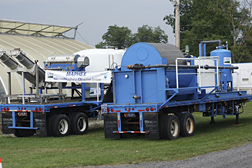| Read the magazine story to find out more. |
|
|
|
|
New System Affords Greater Flexibility on Using Phosphorus from Manure
By Jan Suszkiw
November 14, 2016
U.S. Department of Agriculture scientists and their collaborators have developed a mobile system for removing phosphorus from cow manure that may offer dairy farmers greater flexibility in where, when, and how they use the nutrient to fertilize crops.
Manure can be spread onto crop fields as a source of phosphorus, nitrogen, and other nutrients important to plant growth. But applying too much manure can lead to excess phosphorus that ends up in lakes, rivers, ponds, and other water sources, degrading their quality.
The idea behind the Manure Phosphorus Extraction System (MAPHEX) is to remove the phosphorus and concentrate it in a form that's easier to manage, according to Clinton Church, an environmental chemist with USDA's Agricultural Research Service (ARS) at University Park, Pennsylvania.
Hauling manure off the farm to new locations where it can be spread isn't always practical or economical. However, transporting concentrated phosphorus from the new treatment method could offer a less costly alternative, adds Church. He is with ARS's Pasture Systems and Watershed Management Research Unit.
Church, together with his ARS and Pennsylvania State University colleagues, developed and tested MAPHEX as a way for farmers to not only "mine" phosphorus from their manure stores, but also market the nutrient as a value-added product.
To do this, the team mounted an auger press, centrifuge, vacuum-filter unit, and other components atop two trailer beds so that the entire system could be driven to a farm and operated onsite, either on a daily or rotational basis depending on the size of the dairy operation.
According to Church, the system can service 10 small farms on a 10-day rotational basis. On a larger farm, such as one with 2,000 cows, the system could operate over 24 hours. MAPHEX works quickly. In about 10 minutes, for example, it can extract 99 percent of the phosphorus from 250 gallons of manure. It also removes the odor from the manure.
The MAPHEX team began demonstrating its patent-pending system on a working dairy farm this September and welcomes inquiries on its commercial potential.
ARS is USDA's principal intramural scientific research agency. Read more about the research in the December 2016 issue of AgResearch.

